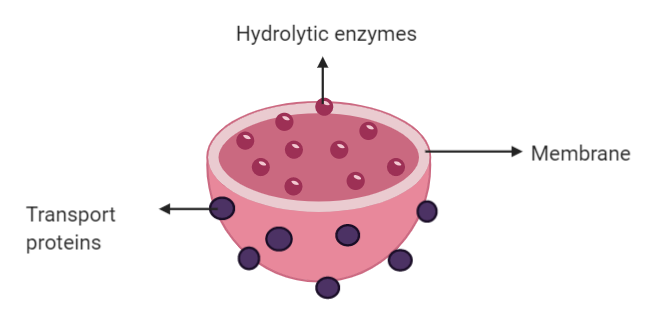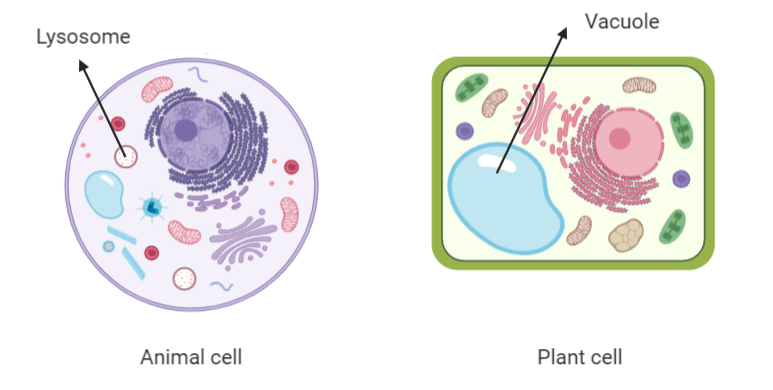
The main function of lysosomes is –
A. Secretion
B. Respiration
C. Extracellular digestion
D. Intracellular digestion
Answer
568.5k+ views
Hint: Lysosomes are single membrane-bound small vesicles. It contains hydrolytic enzymes, digestive enzymes and about 50 enzymes are recorded. It is present in all animal cells except RBCs.
Complete answer:
The lysosome has two main functions. These are as follows –
It helps in the intracellular digestion as it contains the digestive enzymes. When the lysosome in the secondary body stage, it fuses with the phagosomes and helps in the process of digestion.

It acts as the suicidal bag of the cells. It helps in the natural suicide of the cells when they have served their purpose. Under the harsh conditions, they also help the cells in committing forceful suicide by secreting the hydrolyzing enzymes, which digest their own cells.
The lysosome helps in intracellular digestion. This is because digestion occurs within the lysosome, which is inside the cell and not outside.
Hence option D is correct.
Additional Information: The lysosomes are the small sac-like, single-membranous cell organelles that are metabolically active. They are formed from the Golgi bodies. Most commonly they are known as the ‘suicidal bag of the cells’.
The lysosome consists of more than 50 hydrolyzing enzymes or the digestive enzymes. These enzymes are functional only in the acidic medium.

Note: The lysosomes are found only within the animal cells and not the plant cells. The lysosomes are the ‘garbage disposal’ or the ‘suicidal bags’ of the animal cells. To serve the same purpose in plants, a large central vacuole is present, which is not found in the animal cells. Hence, we can conclude that animal cells have lysosomes, and plant cells have vacuoles to contain food.

Complete answer:
The lysosome has two main functions. These are as follows –
It helps in the intracellular digestion as it contains the digestive enzymes. When the lysosome in the secondary body stage, it fuses with the phagosomes and helps in the process of digestion.

It acts as the suicidal bag of the cells. It helps in the natural suicide of the cells when they have served their purpose. Under the harsh conditions, they also help the cells in committing forceful suicide by secreting the hydrolyzing enzymes, which digest their own cells.
The lysosome helps in intracellular digestion. This is because digestion occurs within the lysosome, which is inside the cell and not outside.
Hence option D is correct.
Additional Information: The lysosomes are the small sac-like, single-membranous cell organelles that are metabolically active. They are formed from the Golgi bodies. Most commonly they are known as the ‘suicidal bag of the cells’.
The lysosome consists of more than 50 hydrolyzing enzymes or the digestive enzymes. These enzymes are functional only in the acidic medium.

Note: The lysosomes are found only within the animal cells and not the plant cells. The lysosomes are the ‘garbage disposal’ or the ‘suicidal bags’ of the animal cells. To serve the same purpose in plants, a large central vacuole is present, which is not found in the animal cells. Hence, we can conclude that animal cells have lysosomes, and plant cells have vacuoles to contain food.

Recently Updated Pages
Why is there a time difference of about 5 hours between class 10 social science CBSE

In cricket, what is a "pink ball" primarily used for?

In cricket, what is the "new ball" phase?

In cricket, what is a "death over"?

What is the "Powerplay" in T20 cricket?

In cricket, what is a "super over"?

Trending doubts
What is meant by exothermic and endothermic reactions class 11 chemistry CBSE

Which animal has three hearts class 11 biology CBSE

10 examples of friction in our daily life

One Metric ton is equal to kg A 10000 B 1000 C 100 class 11 physics CBSE

1 Quintal is equal to a 110 kg b 10 kg c 100kg d 1000 class 11 physics CBSE

Difference Between Prokaryotic Cells and Eukaryotic Cells




